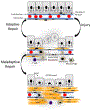Recent advances in acute kidney injury and its consequences and impact on chronic kidney disease
- PMID: 30925515
- PMCID: PMC7020661
- DOI: 10.1097/MNH.0000000000000504
Recent advances in acute kidney injury and its consequences and impact on chronic kidney disease
Abstract
Purpose of review: Acute kidney injury (AKI) remains a major unmet medical need and associates with high morbidity, mortality, and healthcare costs. Among survivors, long-term outcomes of AKI can include development of chronic kidney disease (CKD) or progression of preexisting CKD. In this review, we focus on ongoing efforts by the AKI community to understand the human AKI to CKD continuum, with an emphasis on the cellular stress responses that underlie AKI and the maladaptive responses that persist in the acute-to-chronic phase. The emphasis is on work that has been published in the past year in this rapidly expanding field.
Recent findings: Recent studies in preclinical models highlight the importance of mitochondrial dysfunction, cell death, and inflammation on the underlying pathogenesis of AKI. These pathogenic mechanisms can resolve with adaptive kidney repair but persist in maladaptive repair that leads to progressive chronic disease. The complexity and interconnections of these pathways involve cross-talk between the tubular epithelium, endothelium, and interstitial compartments.
Summary: Approaches which lessen or counteract these cellular responses represent novel strategies to prevent AKI and stop or slow down the progression to CKD.
Figures

References
-
- Mehta RL, Cerda J, Burdmann EA, et al. International Society of Nephrology’s 0by25 initiative for acute kidney injury (zero preventable deaths by 2025): A human rights case for nephrology. Lancet 2015; 385:2616–2643. - PubMed
Publication types
MeSH terms
Grants and funding
LinkOut - more resources
Full Text Sources
Medical
Research Materials
Miscellaneous

